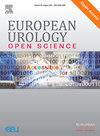Targeted Prostate Biopsies Overestimate International Society of Urological Pathology Grade Group, Particularly in Smaller Tumors
IF 3.2
3区 医学
Q1 UROLOGY & NEPHROLOGY
引用次数: 0
Abstract
Compared with systematic biopsy of the prostate, magnetic resonance imaging (MRI)-targeted biopsies are associated with lower rates of upgrading and higher rates of downgrading between biopsy tissue and radical prostatectomy (RP) specimen International Society of Urological Pathology (ISUP) grade group (GG). Higher rates of downgrading could indicate overtreatment for some patients. We hypothesized that concordance rates between biopsy and RP are different per MRI tumor volume. We conducted an explorative retrospective study to identify the risk factors for downgrading, using RP specimens as the reference standard, in a large regional prostate collaboration. Among 616 patients, pathological concordance was seen in 58% and downgrading in 15%. The risk of downgrading was 18% for tumors of 0–10 mm, 14% for 10–20 mm, and 14% for >20 mm. In a multivariable analysis among patients with targeted biopsy GG ≥2, with covariates including clinical tumor stage, prostate-specific antigen (PSA), maximal MRI index lesion diameter, number of positive target biopsies, and GG at targeted biopsy, the statistically significant predictors for downgrading were PSA, maximum MRI index lesion diameter, and target biopsy GG. A lower risk of downgrading was seen in larger tumors (odds ratio per millimeter 0.95, 95% confidence interval 0.91–1.00, p = 0.033). This study suggests that an overestimation of GG on biopsy is most common in smaller MRI lesions. This information is important in clinical decision-making, mainly in deciding on active surveillance versus active therapy or the indication for additional imaging for cancer staging.
Patient summary
In this report, we examined risk factors that could explain why some patients have higher pathological grading at prostate biopsy than on the whole prostate specimen after surgical removal. We found that patients with prostate biopsies that are targeted at small lesions on magnetic resonance imaging and patients who had high biopsy grading had a higher risk of having lower grading of their surgical specimens.
与系统性前列腺活检相比,磁共振成像(MRI)靶向活检与活检组织和根治性前列腺切除术(RP)标本国际泌尿病理学会(ISUP)分级组(GG)之间的升级率较低,降级率较高。较高的降级率可能表明某些患者接受了过度治疗。我们假设活检和 RP 的一致率因 MRI 肿瘤体积而异。我们开展了一项探索性回顾研究,在一个大型地区前列腺协作组中,以 RP 标本为参考标准,确定降级的风险因素。在616名患者中,病理一致的占58%,降级的占15%。0-10毫米的肿瘤降级风险为18%,10-20毫米为14%,20毫米为14%。在对靶向活检 GG≥2 的患者进行的多变量分析中,协变量包括临床肿瘤分期、前列腺特异性抗原(PSA)、最大 MRI 指数病灶直径、阳性靶向活检次数和靶向活检时的 GG。较大肿瘤的降级风险较低(每毫米几率比 0.95,95% 置信区间 0.91-1.00,P = 0.033)。这项研究表明,活组织检查高估 GG 最常见于较小的 MRI 病灶。这一信息在临床决策中非常重要,主要是在决定积极监测与积极治疗或癌症分期的额外成像指征时。患者总结在这份报告中,我们研究了一些风险因素,这些因素可以解释为什么一些患者在前列腺活检时的病理分级高于手术切除后整个前列腺标本的病理分级。我们发现,在磁共振成像中针对小病灶进行前列腺活检的患者和活检分级较高的患者,其手术标本分级较低的风险较高。
本文章由计算机程序翻译,如有差异,请以英文原文为准。
求助全文
约1分钟内获得全文
求助全文
来源期刊

European Urology Open Science
UROLOGY & NEPHROLOGY-
CiteScore
3.40
自引率
4.00%
发文量
1183
审稿时长
49 days
 求助内容:
求助内容: 应助结果提醒方式:
应助结果提醒方式:


